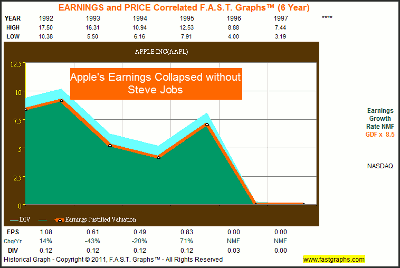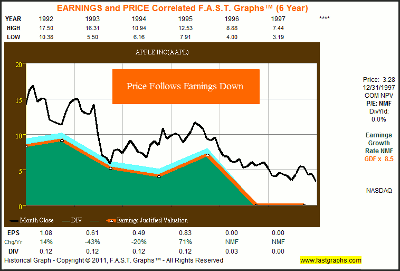The world at large, as well as the worlds of business and technology lost a great iconic leader last week, says Julie Carnevale of FAST Graphs.
In addition to his obvious and widely renowned accomplishments, I believe that Steve Jobs was also a great teacher. Steve Jobs didn’t teach by lecture, instead he taught by his actions.
It marked the second time that Steve Jobs left his beloved Apple (AAPL). However, his latest departure will, I believe, have an entirely different impact on his company then did his first.
The first time Steve Jobs left Apple in 1985, he was fired. In short, his partners in upper management and the Board of Directors at that time did not share Steve’s vision for Apple.
His friend, Larry Ellison, CEO of Oracle Corp (ORCL), recently quipped upon the firing of another high-profile CEO: “That it was the second dumbest decision by a Board of Directors next to Apple’s firing of Steve Jobs.”
What follows, will be a review of the consequences of Steve Jobs’ firing, followed by what he accomplished upon his return.
Apple’s Earnings After Steve Was Fired
The following graphical review looks at Apple Computer’s operating track record from 1992 to 1997, the year upon which Steve Jobs was hired back.
Unfortunately, the F.A.S.T. Graphs™ earnings and price correlated research tool only goes back 20 years, and therefore cannot go all the way back to 1985, the year when Steve was fired. However, the six-year period 1992 to 1997 clearly depicts the ultimate consequences of Apple’s fateful decision.
Earnings per share were on a steady downward trajectory from $1.08 per share in 1992 to losses in 1996 and 1997.
This second graph shows how Apple’s stock price followed its earnings down during this dark period in Apple’s history. The price of Apple stock fell from a high of $17.50 in 1992 to a low of $3.19 by the end of 1997.
Performance results for the period shows that Apple shareholders suffered a compounded annual loss of 21.5% per annum during these last six years of Steve’s absence. To put that into perspective, a $100,000 investment fell to $23,280, for a cumulative 77% loss of shareholder capital.
As is widely known, after Steve Jobs was fired from Apple, he founded NeXT Computer and bought the company The Graphics Group, which he eventually renamed Pixar. In 1996, Apple Computer purchased NeXT Computer, which led to Steve Jobs retaking the reins as interim CEO at first, then permanent CEO by calendar year 2000, until his recent resignation.
Although it took Steve a few years to recalibrate his beloved Apple Computer, the long-term results that followed were extraordinary. It is alleged that Steve once quipped that he was iCEO, obviously referring to the great success of his "i" product launches.
NEXT: When Steve Returned
|pagebreak|When Steve Returned
Since calendar year 1997, Apple Computer under Steve Jobs’ guidance generated earnings growth of 34.4% per annum.
The first few years were a struggle, as Steve reengineered Apple’s products and culture as he recalibrated it back to his own vision. Utilizing Steve’s NeXT technology as its new foundation, and under Steve’s direct order for the development of his "i" vision, Apple Computer’s lineup of offerings was transformed in just one short year.
The rest, as they say, is history. From calendar year 2001 to the present, Apple’s earnings per share have been on an uninterrupted upward trajectory.
It’s crystal clear that shareholders were rewarded handsomely with Steve’s return. Apple Inc.’s stock price has risen from its low of $3.19 in 1997 to its current price above $385.
Shareholder performance after Steve Jobs’ return has been extraordinary, averaging 33.6% per annum during a time when the S&P 500 (the general stock market) only returned 4.5% per annum.
A $100,000 investment on December 31, 1996 held until last Thursday’s close would have grown to over $7,247,648, and this is without the company paying a dividend. The same $100,000 investment in the S&P 500 would have only grown to $192,467, which includes over $38,000 in dividends.
The astounding returns that Apple shareholders enjoyed under Steve’s guidance, although extraordinary, do not, in our opinion, reflect the full value of Apple’s shares. We believe that a strong case could be made that Apple’s stock should be trading at a P/E ratio north of 20, instead of the meager 13.6 PE ratio it currently commands.
In other words, we think that "Mr. Market" is significantly undervaluing Apple’s shares, possibly from the fearful anticipation of his tragic loss of a life too short.
Based on what has been seen and written thus far, it would be easy to conclude that Apple may be in trouble now that Steve Jobs is gone. However, as we alluded to in the opening paragraph of this article, we believe that this second, and unfortunately permanent, departure of Steve Jobs will have an entirely different impact on Apple’s future then did his first temporary sojourn.
Upon his first departure, the Apple Computer Co. rejected Steve Jobs’ vision and took the company on a very different and obviously disastrous direction. However, this time we believe the company continues to embrace the vision that this extraordinary visionary of a man has instilled within every fiber of the company’s current culture.
We believe Steve’s legacy lives on in the hearts and minds of all the Apple employees and culture. Therefore, we further believe that Steve’s contribution will be a lasting one, and that Apple’s future profitability and growth will continue into the distant future.
Subscribe to FAST Graphs here…
Related Reading:





















